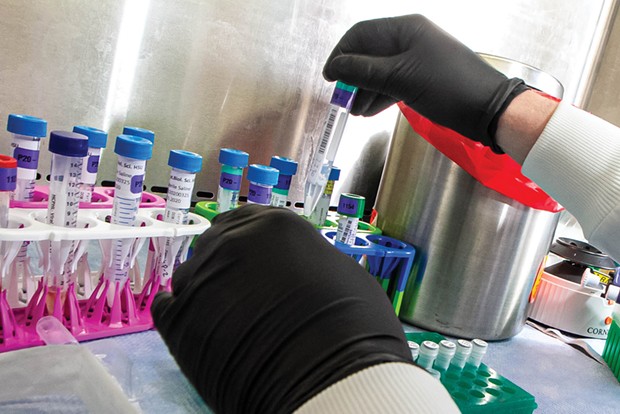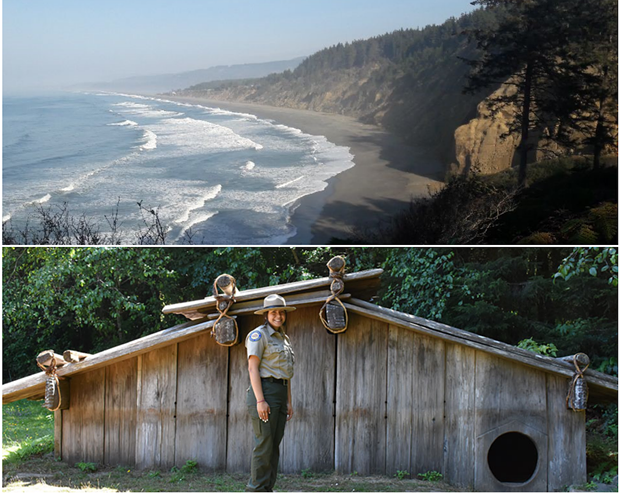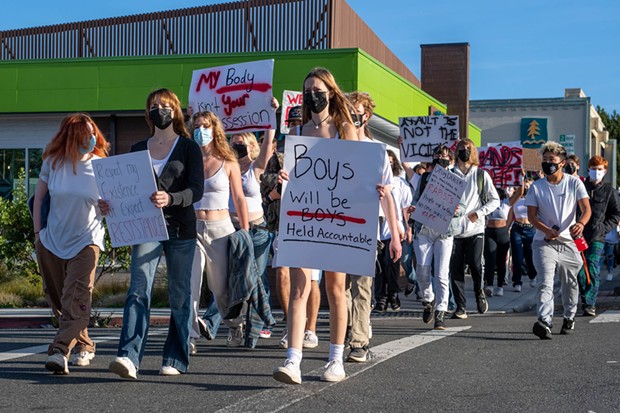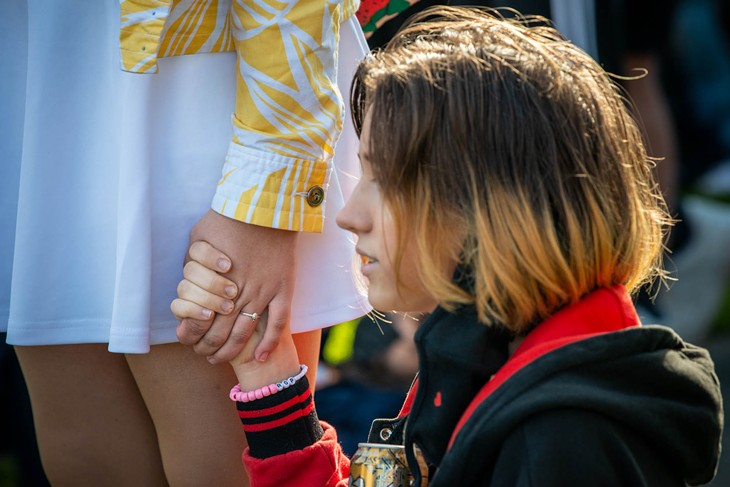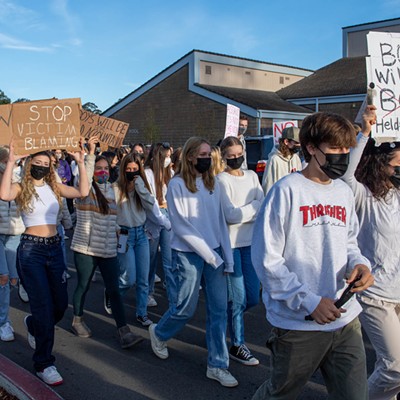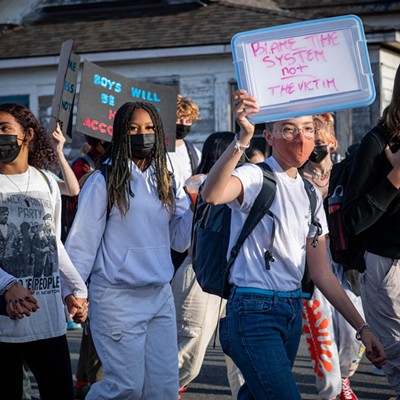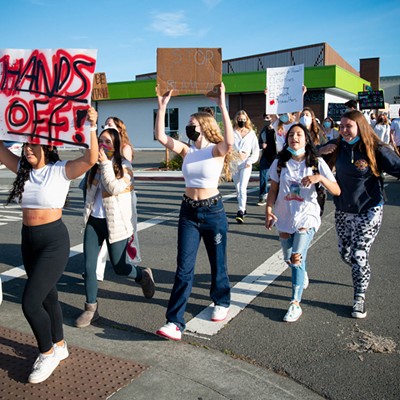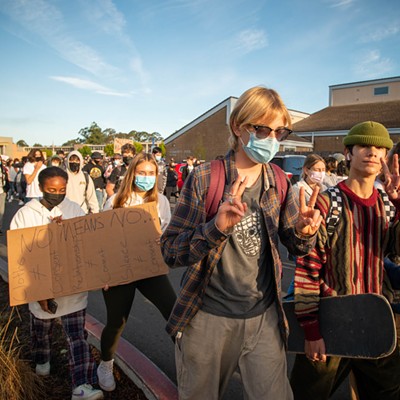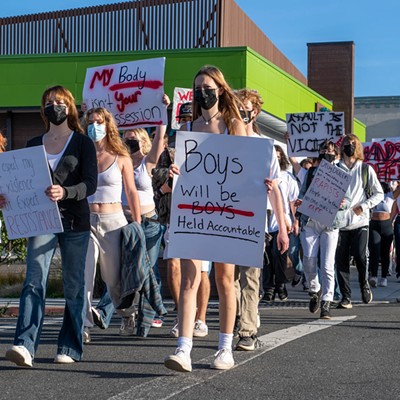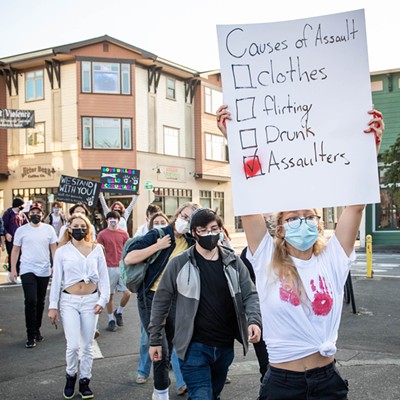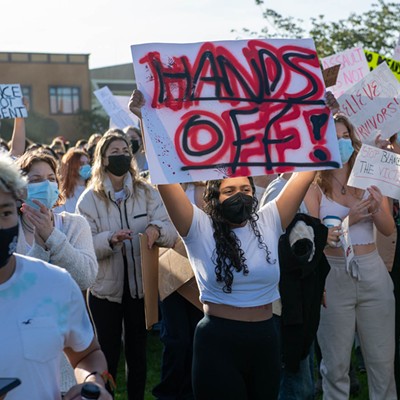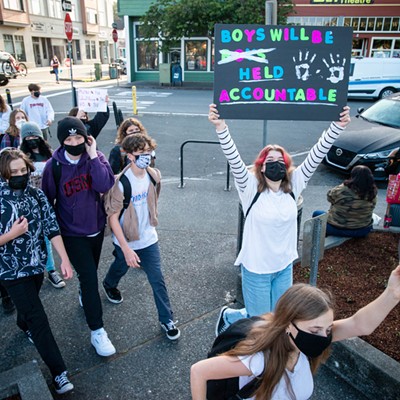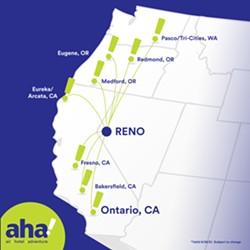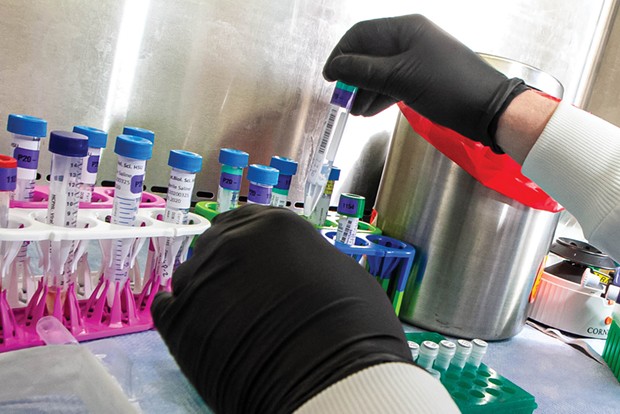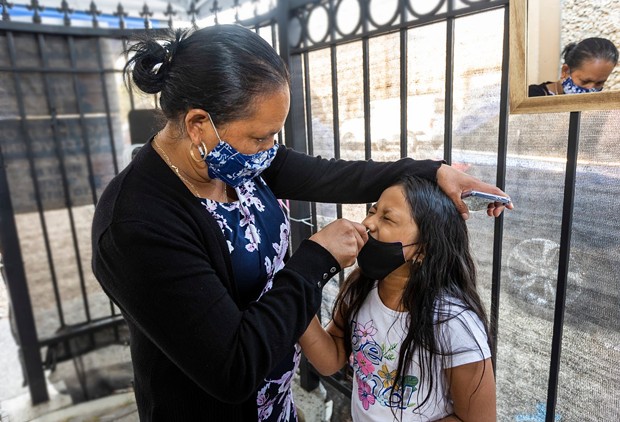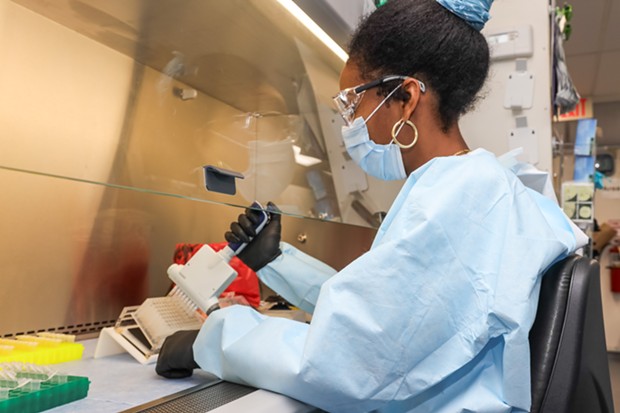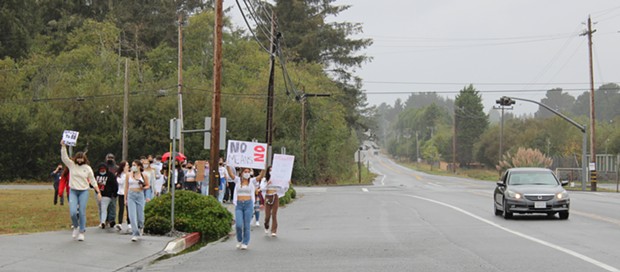Thursday, September 30, 2021
A 98th HumCo Resident Dies of COVID-19
Posted By Thadeus Greenson on Thu, Sep 30, 2021 at 4:16 PM
A 98th Humboldt County resident has died of COVID-19, Public Health reported today, while also confirming 54 new cases of the virus and two new hospitalizations.
A state database shows 29 people currently hospitalized with COVID-19 locally, with five under intensive care. The local hospital census peaked Sept. 3 with 42 COVID-19 patients, then steadily declined over the next couple weeks before creeping back up over the past week.
In today's press release, the county notes that the Centers for Disease Control and Prevention issued ah health advisory yesterday strongly urging pregnant women to get vaccinated due to an increased risk of severe illness from COVID-19.
"Of the more than 125,000 cases reported in pregnant people in the U.S., more than 22,000 were hospitalized and 161 have died," the press release states. "In the month of August alone, 22 COVID-related deaths of pregnant people were recorded, the highest number in a single month since the pandemic began. COVID-19 infection also increases the risk of adverse pregnancy and neonatal outcomes. As of mid-Sept, only 31 percent of pregnant people were fully vaccinated before or during their pregnancy."
Today's cases — which come after 259 were confirmed last week — were reported after laboratories processed 307 samples with a test-positivity rate of 17.6 percent. After recording a test-positivity rate of 10.1 percent in July — the highest for any month since the pandemic began — the rate in Humboldt County jumped to 15.9 percent in August. Through the first 30 days of September, it sits at 15.2 percent, far outpacing state (3.1 percent) and national (8.1 percent) rates.
Due to the high rates of local transmission, Health Officer Ian Hoffman today issued a statement recommending physical distancing in all public meetings and urging virtual alternatives, where possible.
State Commission Votes to 'Restore the Name Sue-meg,' Remove Patrick's Point from Park's Name
Posted By Kimberly Wear on Thu, Sep 30, 2021 at 11:32 AM
State Parks acquired Patrick's Point in 1930 and kept the name already in use since the 1800s, in reference to Patrick Beegan, an Irish immigrant who laid a brief claim to the jutting peninsula located on Yurok ancestral lands.
Beegan was accused of murdering numerous Native Americans, including a young Yurok boy, and lost the property after fleeing law enforcement in connection with the murder.
Read an expanded story about the meeting and the decision to restore the name Sue-meg to the Humboldt County state park here.
Read the Yurok Tribe's release below:
Today, the California State Parks and Recreation Commission unanimously approved the Yurok Tribe’s request to change the name of Patrick’s Point State Park to Sue-meg State Park, an acknowledgement of the designation the Yurok people have always used to describe the place.
“This genuinely historic decision represents a turning point in the relationship between tribes and the state. We asked the Commission to alter the name of the park because we have an obligation to ensure the next generation inherits a more just world,” said Joseph L. James, the Chairman of the Yurok Tribe. “On behalf of the Yurok Tribe, I would like to thank the Commission for accepting our request to restore the name of this important part of our ancestral territory. We are equally grateful for the support we received from California State Parks and North
Coast Redwoods District Superintendent Victor Bjelajac. I’m so glad that Sue-meg will now be referred to by its correct name.” “We would not be able to achieve this amazing accomplishment without the generations of Yurok people who sacrificed so much to maintain our indelible connection to Sue-meg Village. I also appreciate the hundreds of community members who asked the Commission to vote in favor of the name change,” added Yurok Tribal Council Member Sherri Provolt, who represents the Orick District. “Sue-meg has been and will always be an important place for every Yurok citizen, many of whom have familial ties to the village dating back to the beginning of time.”
“The Yurok people have always referred to this place as Sue-meg and now it will forever be called its correct name. We continue to practice our cultural traditions at Sue-meg just as our ancestors did for millennia,” added Rosie Clayburn, the Yurok Tribal Heritage Preservation Officer. “For me, the decision represents an acknowledgement of an injustice that we have endured for 170 years following the colonization of our ancestral homeland. Renaming the park is an important step toward healing the wounds the state inflicted on our people.”
Based on the government-to-government relationship between tribal nations and the state, the Yurok Tribe requested and received an extended period of time for Chairman James to inform the Commission about why the park should be renamed. At today’s meeting, Chairman James described in detail the Tribe’s longstanding link Sue-meg Village, which occupies a prominent bluff on the far Northern California coast. Located in the general vicinity of the park, the village of Sue-meg is a culturally invaluable place for the Yurok Tribe. Every year prior to the pandemic, Yurok families held Brush Dances at a site within the current park boundaries. Hundreds of tribal citizens typically attend the healing ceremony.
Many ceremonial leaders attended today’s meeting to voice their support the name Sue-Meg State Park.
“I will feel a lot better working in the park now that it is called its Yurok name, its original name,” said Dr. Walt Lara Sr, who managed the construction and maintenance of the ceremonial site at Sue-meg.
The park’s former namesake, Patrick Beegan, committed acts of violence against Yurok people. Around the time of the Gold Rush, Beegan murdered a young Yurok boy near Chue-rey (Tsurai - Trinidad) area and is believed to have killed additional tribal citizens. During this tumultuous part of the Tribe’s history, Yurok men, women and children faced unspeakable, state-sanctioned violence over the course of decades.
The renaming of the park aligns with a growing movement to remove public monuments bearing the appellations and likenesses of individuals who perpetrated atrocities against people of color. Since May of 2020, more than 100 symbols have been eliminated from numerous cities across the US.
Earlier this month, California Governor Gavin Newsom signed a bill — proposed by Assemblymember James C. Ramos and endorsed by the Yurok Tribe — to replace the statue of father Junipero Serra at the Capitol with an art installation that honors the many tribal nations in the state.
California Governor Gavin Newsom’s 2019 Executive Order N-15-19 also played a positive role in the state park name revision. The historic order included an apology for the state’s role in the attempted genocide of Native Americans and a pledge to work more with Tribes on addressing the wrongs of the past. The Governor also formed a Truth and Healing Council and appointed tribal leaders to serve on the advisory board.
Yurok Vice Chairman Frankie Myers was selected to be a member of the Council, which seeks to create an accurate account of California’s involvement in the massacre of indigenous people, so that the relationship between tribes and the state may one day flourish. The comprehensive record will serve as a sturdy foundation from which to mend the relationship between tribes and the state.
“The partnership between the Yurok Tribe and North Coast Redwoods District Superintendent Victor Bjelajac is a shining example of how state governments can work with tribal nations to create a more inclusive and prosperous future for generations to come,” concluded Chairman James.
The Yurok Tribe is the largest Tribe in California with more than 6,300 members. The Tribe’s ancestral territory comprises 7.5 percent of the California coastline, spanning from the Little River to the south and Damnation Creek to the north. The Tribe’s major initiatives include: holistic forest management, fisheries protection, restoration and management, Klamath dam removal, condor reintroduction, natural resources conservation, cultural preservation, sustainable economic development and land acquisition.
Arcata High Students Walk Out to Stand with Sexual Assault Survivors
Posted By Thadeus Greenson on Thu, Sep 30, 2021 at 11:06 AM
For the third consecutive day, students walked off a high school campus in Humboldt County on Wednesday to stand in solidarity with survivors of sexual assault and protest what they feel are inadequate administrative and societal responses.
Hundreds of Arcata High School students descended on the Arcata Plaza yesterday morning, many clad in white or holding signs emblazoned with slogans like "no means no." They then listened as student after student came forward to share stories of sexual assault and sexualized trauma. The walkout followed similar ones sat Eureka, Fortuna and McKinleyville high schools Monday and at South Fork High School and Academy of the Redwoods on Tuesday.
The week of walkouts follows Southern Humboldt reporter Kym Kemp's report Sunday of a Fortuna High School student's allegation she was sexually assaulted by a fellow student in August during a party at Centerville Beach — an allegation currently under investigation by the Humboldt County Sheriff's Office — and the student's feeling that the school had failed to take appropriate action after the alleged assault was reported.
Local photographer Mark McKenna was on scene yesterday to document the Arcata High School walkout, which included hundreds of students and spanned several hours. See his photos below.
Wednesday, September 29, 2021
Public Health Reports Four New COVID Hospitalizations, 40 New Cases
Posted By Thadeus Greenson on Wed, Sep 29, 2021 at 3:59 PM
Humboldt County Public Health confirmed 40 new COVID-19 cases this afternoon — making 149 so far this week — as well as four new hospitalizations.
Public Health also reported today that over the course of the last seven days, the ranks of Humboldt County's fully vaccinated population have grown by 909 people.
A state database shows 28 people currently hospitalized with COVID-19 locally, with four under intensive care. The local hospital census peaked Sept. 3 with 42 COVID-19 patients, then steadily declined over the next couple weeks before creeping back up over the past week.
"The county has seen a slight improvement in the cases and hospitalization rates, but local health officials caution that both metrics are still higher than at any point before August, the deadliest month of the pandemic," a Friday press release stated.
Today's cases — which come after 259 were confirmed last week — were reported after laboratories processed 401 samples with a test-positivity rate of 10 percent. After recording a test-positivity rate of 10.1 percent in July — the highest for any month since the pandemic began — the rate in Humboldt County jumped to 15.9 percent in August. Through the first 29 days of September, it sits at 15.1 percent, far outpacing state (3.1 percent) and national (8.1 percent) rates.
Humboldt County's seven-day average daily rates of new cases per 100,000 residents (22.4) and deaths per 100,000 (0.85) also far outpace those of the state, which is averaging 16.4 new cases and 0.2 deaths daily per 100,000 in population.
Flights to Tahoe Coming in November
Posted By Kimberly Wear on Wed, Sep 29, 2021 at 12:17 PM
According to a news release, ExpressJet's line aha! will operate the flight on
The returns flights will run on the same days, leaving Reno-Tahoe at 9:30 a.m. and arriving in Humboldt County at 10:40 a.m.
“We are extremely excited to welcome another new airline partner, aha!, to ACV and Humboldt County,” Cody Roggatz, aviation director for Humboldt County, said in the release. “This new service will provide Humboldt County Residents nonstop airline access to all of the entertainment and adventure options exclusive to the greater Reno-Tahoe Region through their local hometown airport.”
Find more information below:
Judge Requires COVID Vaccines for California Prison Workers
Posted By Byrhonda Lyons/Calmatters on Wed, Sep 29, 2021 at 6:31 AM
For months, the politically powerful union and the Newsom administration have resisted a COVID vaccine mandate for prison workers, despite the spread of the deadly virus behind prison walls. Those outbreaks have increased with the rise of the more contagious delta variant: From August to mid-September, the ruling noted, a “staggering” 48 outbreaks have been traced back to prison staff.
Since the pandemic began, more than 50,000 California state prisoners have tested positive for COVID-19 and 240 have died. Yet to date only about 42 percent of guards and 57 percent of all prison staffers are fully vaccinated.
California currently requires unvaccinated prison workers to submit to frequent COVID tests.
State officials have tried cash incentives, behavioral science strategies, even one-on-one counseling to entice more of them to get the shots. But most resisters didn’t budge. Although more than 5,000 staff attended the one-on-one counseling sessions, a mere 262 agreed to be vaccinated. Roughly 4,300 others signed a statement of refusal.
U.S. District Judge Jon S. Tigar in Oakland concluded there was no evidence that further efforts to boost voluntary vaccination would be any more successful. A mandate, he added, ”would lower the risk of preventable death and serious medical consequences among incarcerated persons. And no one has identified any remedy that will produce anything close to the same benefit.”
Prison employees can avoid the COVID vaccine mandate if they have a medical or religious exemption.
“We’ve undertaken an aggressive, voluntary vaccination program and we still believe the voluntary approach is the best way forward,” Glen Stailey, president of the California Correctional Peace Officers Association, said in a text message. “We are looking into our legal options to address this order.”
The judge said the state disregarded a substantial risk of serious harm to prisoners, violating their Eighth Amendment rights. The lawsuit on behalf of prisoners was brought by the Prison Law Office.
The California Department of Corrections and Rehabilitation said in a statement that it was evaluating the order to “determine next steps.”
“We respectfully disagree with the finding of deliberate indifference, as the department has long embraced vaccinations against COVID-19, and we continue to encourage our staff, incarcerated population, volunteers, and visitors to get vaccinated,” wrote the department spokesperson.
State data shows that more than 20,000 prison workers have contracted COVID and 39 have died from the virus since the pandemic’s onset. Staff outbreaks and exposure to COVID-19 led to about 5,500 prison staff absences, delayed inmate care and created a backlog of 13,000 health care appointments, according to the ruling.
COVID testing alone isn’t enough
A federally appointed receiver has overseen the medical care of California prisoners for years, the result of a class action lawsuit over inmate treatment. A month ago, receiver J. Clark Kelso filed a report recommending the state require COVID vaccines for prison staff, citing the spread of the delta variant.
“Frequent testing is insufficient to prevent institutional staff who are unaware that they have COVID‐19 from spreading the virus,” the receiver wrote.
In a May 2021 response to a question about COVID vaccine requirements, Gov. Newsom indicated that he didn’t plan on getting ahead of the California prison guards union, which donated $1.5 million to help him fend off a recall election.
“We have no further announcement to make as it relates to whether or not we’re going to mandate those vaccines,” said Newsom, adding that he was relying on the guards’ union to convince more of its own to get the shots.
In a previous story, CalMatters spoke to several correctional officers opposed to getting vaccinated.
“No. Never will,” answered a prison guard at California Rehabilitation Center in Norco.
“A lot of us have already had COVID and recovered, so we don’t see the point in getting the vaccine,” said another Norco guard, who tested positive for COVID in December of 2020.
The judge who issued Monday’s ruling didn’t set a deadline for the state to comply with the ruling. Instead, the receiver and state attorneys will create a plan that sets the deadline
California would not be the first state to institute a COVID vaccine mandate for prison guards. Nevada did so earlier this month.
Tuesday, September 28, 2021
HumCo Records Three More COVID-19 Deaths, 46 New Cases
Posted By Thadeus Greenson on Tue, Sep 28, 2021 at 4:01 PM
Three more Humboldt County residents have died of COVID-19, Public Health reported today, while confirming 46 new cases of the virus and two new hospitalizations.
The residents who died were in their 70s, according to Public Health, and make 22 COVID-19 deaths so far this month — matching August's record tally — including nine over the past seven days.
A state database shows 27 people currently hospitalized with COVID-19 locally, with four under intensive care. The local hospital census peaked Sept. 3 with 42 COVID-19 patients, then steadily declined over the next couple weeks before creeping back up over the past week.
"The county has seen a slight improvement in the cases and hospitalization rates, but local health officials caution that both metrics are still higher than at any point before August, the deadliest month of the pandemic," a Friday press release stated.
Today's cases — which come after 259 were confirmed last week — were reported after laboratories processed 296 samples with a test-positivity rate of 15.5 percent. After recording a test-positivity rate of 10.1 percent in July — the highest for any month since the pandemic began — the rate in Humboldt County jumped to 15.9 percent in August. Through the first 28 days of September, it sits at 15.3 percent, far outpacing state (3.1 percent) and national (8.1 percent) rates.
Humboldt County's seven-day average daily rates of new cases per 100,000 residents (21.9) and deaths per 100,000 (0.95) also far outpace those of the state, which is averaging 16.4 new cases and 0.2 deaths daily per 100,000 in population.
Rapid COVID-19 Tests in Short Supply in California
Posted By Kristen Hwang/CalMatters on Tue, Sep 28, 2021 at 6:26 AM
But in recent weeks, the staff has struggled to purchase enough rapid test kits. The local Walgreens and Costco have started limiting sales to one per customer. “We ran into the same issue at the beginning of the pandemic when we were trying to buy Clorox wipes and hand sanitizer,” said Voit, the shelter’s program director.
Three weeks ago, a child living at the shelter was sent home from school after a classmate contracted COVID-19. Voit’s team used the rapid tests on the whole family. They all came back positive.
“Because we had those kits on hand, we were able to send them immediately to the isolation and quarantine hotel the county runs,” she said. “Otherwise it could have taken three to five days to get those results and many more families could have gotten sick.”
A nearby clinic offers COVID-19 tests, but only PCR tests, which usually take several days for results. Even a single day’s wait could fuel an outbreak among the shelter’s 23 adults and children.
“If a resident really needs a test, we can send them there,” Voit said, “but the three to five days is tough to wait.”
Voit managed to find an online supplier and ordered 70 kits for the shelter, but they aren’t coming anytime soon: The delivery date is a month out.
Online and in stores, major retailers are sold out of the popular at-home tests, and medical supply vendors can’t find enough rapid test kits for schools, shelters, nursing homes, employers and other groups. Across the state, people in low-income communities are being turned away as community groups and clinics are forced to ration their tests. Workers in need of regular screening for employment struggle to find them.
Some parents are spending hundreds of dollars out-of-pocket to test their school kids. And nursing homes are told they may have to wait weeks for testing kits. “The U.S. gets a D- when it comes to testing,” said John Swartzberg, an infectious disease expert and professor emeritus at UC Berkeley. “We’re not doing enough of it and it’s too difficult for people to get tests. Those with the least resources have the greatest difficulty in finding a free test site or purchasing at-home testing.”
“Those with the least resources have the greatest difficulty in finding a free test site or purchasing at-home testing.”
Dr. John Swartzberg, UC Berkeley
Experts say quick and easy testing is vital to contain the spread of COVID-19. Without widespread access to tests, people don’t know they are infected and need to quarantine, causing outbreaks that could have been prevented.
“There should be little stations where you can get rapid tests anywhere, anytime,” said Joe DeRisi, professor of biochemistry and biophysics at UC San Francisco.
Rapid test kit shortages abound
It’s a mismatch of supply and demand. Although the state is reporting record-high testing numbers, Californians seeking same-day results and over-the-counter test kits for sniffling kids, employer verification, or merely peace of mind say they are unavailable. The problem: Nearly all state-run testing facilities offer only laboratory-based PCR tests, and people want rapid ones instead.
When the Delta variant reared its head, the shortage of rapid tests created the “perfect storm,” experts say. The surge coincided with schools reopening and employers requiring quick, routine testing. At the same time, local health departments scaled back their testing efforts, focusing on vaccinations instead. Manufacturers, seeing decreased summer demand, reportedly shuttered production lines and tossed unsold product.
Fewer than 10% of testing locations across the state now offer rapid-result antigen tests, according to a database from Coders Against COVID and URISA GISCorps.
The test shortage is so severe that the federal government has stepped in to increase production. On Sept. 9, the Biden Administration announced a national COVID-19 action plan that includes the purchase of 280 million rapid point-of-care and over-the-counter tests by the federal government and a three-month deal with Walmart, Amazon and Kroger to sell the tests at cost.
The U.S. Department of Health and Human Services did not respond to requests inquiring how many rapid tests would be allocated to California.
Industry experts say manufacturers, including Abbott Laboratories, are picking up production, but adequate supplies have yet to hit the shelves for consumers — and it could be weeks off.
“We have been told by this particular manufacturer that they’ve caught up, but clearly at the customer level we still see shortages, and of course customers are shifting to other brands which cascade the shortage elsewhere,” said Nam Tran, professor of clinical pathology at UC Davis and a member of the state’s COVID-19 Testing Task Force.
Despite the slightly lower sensitivity of rapid tests compared to laboratory-based PCR ones, the ease of the at-home options make them ideal for community surveillance, DeRisi said. PCR tests can detect lower levels of virus and potentially catch an infection sooner, but the reality is the inconvenience of scheduling an appointment means people aren’t getting tested enough.
“I could get a PCR, but that’s just a snapshot in time,” Tran said. “If you want people to test every day, (PCR) is not feasible.”
About 90% of all PCR test results are returned in two days, according to state data, although that time has steadily crept upward recently. The 15 minutes of wait for a home rapid test compared to 48 hours could mean the difference between an infectious person starting quarantine immediately versus spreading the virus for several days.
And it’s clear that rapid testing works.
Fewer than 10 percent of testing locations across the state now offer rapid-result antigen tests.
The Mariposa skilled nursing facility that Katrina Anderson manages hasn’t had a single case of COVID-19 among its frail residents since the beginning of the pandemic.
In addition to other strict infection control policies, every person that enters the building is given a rapid test.
“If you come to work in our facility you’re tested. If you come to fix something that’s broken in the facility, you’re tested,” Anderson said. “Nobody enters without getting a rapid test.”
Anderson received word from the state that tests were in short supply. She was able to secure enough kits for the next few weeks. But other organizations, like schools and community groups, attempting to set up rapid testing through the California Department of Public Healthmay not be so lucky. The Testing Task Force website warns that it will take six to eight weeks to receive the state’s rapid test kits.
Schools desperate for test supplies
In March, the state offered 5 million BinaxNOW tests to schools as an optional incentive to reopen in the spring.
Rapid testing is a major strategy for schools eager to avoid kids’ time spent out of the classroom sick or in quarantine. But the state program has been swamped with orders, and some schools say PCR testing is their only reliable option right now.
State public health officials told Kern High School District in Bakersfield “that there is a nationwide shortage of antigen/rapid tests,” said Erin Briscoe-Clarke, a district spokesperson. So the school is using PCR tests instead despite the longer wait time for results.
DeRisi from UCSF said he heard that “hundreds of schools” signed up in September for the state tests, “right when the shortage occurred and right when the Delta bump hit.”
The state Department of Public Health did not return requests for comment about its ability to fill schools’ orders.
Officials at the Clovis Unified School District northeast of Fresno said they have struggled to secure enough rapid tests for their 43,000 students. In addition to required masking and daily health screenings, the schools there routinely test students involved in extracurricular activities and are gearing up to begin testing faculty weekly. The schools also shorten the 10-day quarantine period by three days if a student can prove they are COVID-negative.
But the Clovis district was notified earlier this month that the state may not be able to fill its test kit order, spokesperson Kelly Avants said. “We got our order in and heard within a day or two that the state was no longer accepting additional orders because they were out,” Avants said.
Early this month, the Clovis district contacted more than 40 vendors in search of rapid test kits. Nobody had any in stock and wouldn’t until at least October, maybe even December. Eventually, the state was able to fulfill the district’s order.
“Like so many other supply chains right now, it is unpredictable,” Avants said.
“We got our order in and heard within a day or two that the state was no longer accepting additional (test kit) orders because they were out.”
Kelly Avants, Clovis Unified School District
The district has about a two-week supply of tests, and expects a delivery of 12,800 more from a private vendor soon.
Without rapid testing readily available publicly, some parents are spending hundreds of dollars to monitor their kids’ health.
Nayamin Martinez, a parent in Clovis Unified, received an email several weeks ago that a child in her daughter’s classroom tested positive for COVID-19.
It was a Friday afternoon, and the family’s local Kaiser testing clinic was closed. Even with insurance, Martinez couldn’t find a rapid test kit or same-day appointment anywhere. She also knew that results from a PCR test wouldn’t come until the following Monday or Tuesday and didn’t want to keep her daughter out of school needlessly.
Martinez wound up taking her to urgent care and paying $270 for the rapid test — and her peace of mind.
Hundreds of testing sites shut down
The California Department of Public Health says there’s a glut of PCR testing capacity. Thousands of same-day appointments for the tests are available through the state testing website, and more tests are processed daily now than during the winter surge. OptumServe, which manages the state’s testing efforts, works with the state to monitor demand and offer drive-thru, mobile and fixed site options, health officials told CalMatters.
Yet many Californians complain that they can’t find an appointment or a rapid test. The issue: As government-run mass testing sites have closed, it’s not always clear to people where new locations have sprung up.
“You end up with barriers to access that have less to do with capacity and more to do with lack of information,” said Dr. Jorge Caballeros, a physician and founder of Coders Against COVID, a volunteer group that crowdsources a directory of test sites nationally.
“More of the testing has shifted from a government-based or public health service and become privatized. A lot has shifted to primary care physicians, health systems and to companies that are running these tests,” he said.
According to the Coders Against COVID database, 900 testing sites have closed in California since April 2020, and that’s likely an undercount.

Working-class and immigrant communities that often face technological or language barriers are struggling with the shifting test locations and longer turnaround times. Community organizations have been left to fill the gaps with what little supplies they have left.
“We’re still the only organization in Marin County that’s doing rapid testing for free, and I don’t understand why,” said Yolanda Oviedo, COVID-19 response manager at Canal Alliance. “It’s been really hard for us to maintain.”
Canal Alliance, which provides an array of services for the Latino community in Marin, offers rapid testing two days a week.
The pandemic hit the county’s Latino population hard. Latinos accounted for 80% of the county’s COVID-19 cases last year despite making up less than 16% of the population. Most are essential workers with high risks of exposure.
Oviedo said the group received 5,000 test kits from the state in May and have used more than 3,000. Demand has grown since August, and they have resorted to limiting testing to 100 people per day in order to make supplies last as long as possible.
People seeking tests at the site are frequently turned away. It’s a tough decision, especially when they know community members are desperate, said Marina Palma, San Rafael City Schools board member and volunteer at Canal Alliance.
“We have people coming to test with us from Richmond, Petaluma, Novato, San Francisco,” Palma said.
“When I heard we were capping (tests), I asked ‘Why don’t you order more?’ They said ‘There’s no more to order. They’re on backlog.’”
Nayamin Martinez, Central California Environmental Justice Network
Increasingly employers, like Amtrak and Goldman Sachs, are requiring proof of vaccination or negative test results, and many workers can’t afford to miss a day of work.
“When you go to other places, it takes two days for the results. Two days means a lot for those families who work labor,” Palma said. “If they don’t have that verification, they can’t support their families.”
It’s a similar story in the Central Valley, where Martinez, the Clovis parent, is the executive director of the Central California Environmental Justice Network. Her organization, which partnered with UC Davis, is the only place in Yolo, Stanislaus, Madera and Fresno counties offering rapid tests.
Several weeks ago they, too, started capping the tests at 100 per day.
“When I heard we were capping (tests), I asked ‘Why don’t you order more?’ They said ‘There’s no more to order. They’re on backlog,’” Martinez said.
Many of the people they test have Medi-Cal or are uninsured, and are unable to get appointments at local health clinics. Routine testing for employers isn’t necessarily covered by insurance.
Every day around 5 a.m., people start calling Martinez, desperately searching for a free test. “It’s bureaucracies after bureaucracies. It’s exhausting,” she said.
Monday, September 27, 2021
Public Health Reports Another COVID-19 Death, Four New Hospitalizations
Posted By Thadeus Greenson on Mon, Sep 27, 2021 at 4:26 PM
Humboldt County Public Health reported today that it has confirmed 63 new COVID-19 cases since Friday, with four new hospitalization and another COVID-19 death, the county's 94th.
The resident who died was in their 50s, according to Public Health, with one resident each in their 20s, 30s, 40s and 50s accounting for the new hospitalizations.
A state database shows 27 people currently hospitalized with COVID-19 locally, with seven under intensive care. The local hospital census peaked Sept. 3 with 42 COVID-19 patients, then steadily declined over the next couple weeks before creeping back up over the past week.
"The county has seen a slight improvement in the cases and hospitalization rates, but local health officials caution that both metrics are still higher than at any point before August, the deadliest month of the pandemic," a Friday press release stated.
Today's cases — which come after 259 were confirmed last week — were reported after laboratories processed 668 samples with a test-positivity rate of 9.4 percent. After recording a test-positivity rate of 10.1 percent in July — the highest for any month since the pandemic began — the rate in Humboldt County jumped to 15.9 percent in August. Through the first 27 days of September, it sits at 15.3 percent, far outpacing state (3.1 percent) and national (8.1 percent) rates.
Humboldt County's seven-day average daily rates of new cases per 100,000 residents (24.7) and deaths per 100,000 (1) also far outpace those of the states, which is averaging 17.3 new cases and 0.2 deaths daily per 100,000 in population.
Students Stage Walkouts on Three Local Campuses to Support Sexual Assault Survivors
Posted By Thadeus Greenson on Mon, Sep 27, 2021 at 2:09 PM
Students walked out of class on at least three Humboldt County high school campuses this morning to stand in solidarity with survivors of sexual assault.
Most wearing white and many holding signs, students at Fortuna, Eureka and McKinleyville high schools participated in the planned walkouts, with Fortuna and McKinleyville students marching the streets surrounding their campuses.
The walkouts come after two separate reports of sexual assault — one involving students at Fortuna High School and the other involving students of another local high school. In a story published yesterday, Kym Kemp, an independent local reporter based in Southern Humboldt, details the story of a 15-year-old Fortuna High School student who says she was sexually assaulted by a drunken fellow student who is on the football team shortly after midnight Aug. 8 during a party at Centerville Beach, leaving her “sobbing.”
